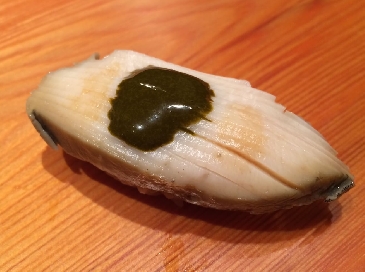Shellfish


Japanese abalone (Kuro awabi)
【Nigiri sushi: Kai】
What is Kuro-awabi?
Imported Awabi (abalone) comes to Japan from Australia and Canada, but the flavor isn’t as good as domestically produced abalone. In conveyor belt sushi, Rokogai (Barnacle Rock-shell) and Akaawabi (Red abalone) are sometimes used to imitate Kuro awabi (Japanese abalone).
The five types of abalone eaten in Japan include Japanese abalone (黒鮑), disk abalone (雌貝鮑), ezo abalone (蝦夷鮑), giant abalone (真高鮑) and Tokobushi (常節). Japanese abalone and ezo abalone are good raw while giant abalone and disk abalone can be enjoyed steamed. The chewy texture of raw abalone is from the scleroproteins collagen and elastin. Steaming it with sake softens the collagen into gelatin, softening the texture as well.
What does Kuro-awabi (Japanese abalone) nigiri sushi taste like?
Sea grass-feeding abalone has a tasty meat with crunchy texture and fine flavor of ocean. By steaming, it gets even tastier and takes on more firmness. Every juicy bite is like a bliss.
It is exquisite in the summer when glycogen has accumulated in its body. Glycogen itself is tasteless and odorless, but when combined with glutamic acid and adenylic acid, it increases the richness of the abalone's natural flavor. The sweetness of glycine and betaine also adds to this, making it the most delicious of all conch.
【How to prepare abalone】
There are several methods of preparing abalone. All of them are designed to soften the abalone and bring out its flavor and aroma to the maximum extent possible.
There are two types of cooking methods for Ni-awabi (boiled abalones): Saka-ni (sake-boiling), in which abalones are boiled with a lot of sake, and shoyu-ni (soy sauce-boiling), in which abalones are boiled with soy sauce and other seasonings.
Mushiawabi (Steamed abalones) using a steamer can also be prepared in a variety of ways, such as steaming with sake, salt, or no seasoning.
Sake is added to the abalones so that the umami of the sake can soak into the abalones, reduce their odor, and bring out their soft texture while leaving them chewier. As a side note, sushi restaurants also have a custom of calling the abalones stewed and softened "Mushi-awabi (Steamed abalones). To be precise, they are Ni-awabi (boiled abalones).
【Trivia】
Abalone is thought to be a lucky charm that symbolizes good fortune and longevity, and legend has it that the Qin Emperor, the first ruler to unite China, traveled all the way to Japan to find the coveted shellfish in search of immortality.
【Substitute fish】
Chilean abalone: Concholepas concholepas (Bruguie, 1789)
Grand Keyhole Limpet
Variously coloured abalone: Haliotis diversicolor diversicolor Reeve,1846
Red abalone: Haliotis (Nordotis) rufescens Swainson,1822
South African abalone or the perlemoen abalone: Haliotis midae
Blacklip abalone or Earshell: Haliotis ruber Leach.1814
【Related contents】
Abalone around the world
What is Tokobushi abalone sushi?
List of Shellfish (Kai)
(Revision date: April 14, 2025)

